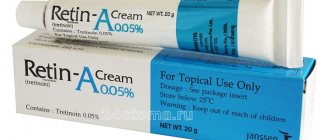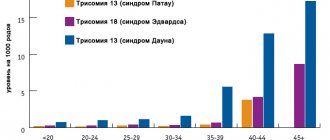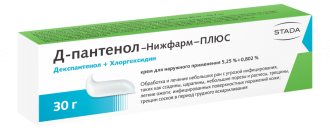Oxolinic ointment for papillomas is quite popular among residents of the CIS countries. Let's look at whether this drug is really an effective treatment for viral skin diseases and how justified its use is.
Oxolinic ointment is a popular antiviral agent, but its effectiveness has not been proven
Let us consider the properties of the drug in more detail.
Mechanism of action
The instructions for use indicate that oxolin has antiviral properties. It blocks the entry points of viral particles in cell membranes, thereby preventing them from entering cells.
According to the developers, the drug is effective against:
- influenza viruses;
- adenoviruses;
- herpes virus;
- human papilloma virus.
When the product is applied to the skin, 5% of the active substance is absorbed, and when applied to the mucous membranes - 3%.
Oxolin does not accumulate in the human body; a small amount of it ingested when using the ointment is excreted primarily by the kidneys within 24 hours from the moment of use.
Application of the drug to intact skin and mucous membranes does not have a locally irritating or toxic resorptive effect.
How to use
Depending on the purpose of the therapy, Oxolinic ointment can be used in different ways:
| Indication | How to apply |
| Prevention and treatment of influenza, ARVI | Before using the ointment, it is advisable to rinse your nose with saline solution of sodium chloride or boiled water. The ointment is applied with a cotton swab 2-3 times a day in a thin layer. |
| Treatment of herpetic dermatitis, herpes zoster | Lubricate the elements of skin rashes 5-6 times a day. Therapy continues until epithelization is complete. |
| Treatment of warts and condylomas | The ointment should be applied to the surface of the tumor 2-3 times a day, after lightly rubbing it with a soft washcloth. The course of treatment lasts from 15 to 60 days. |
Composition and dosage forms
The ointment is a homogeneous viscous substance of yellowish or white color. Contains the active substance - oxolin. Its concentration in 1 g of the drug, depending on the purpose, is 0.25 or 3%.
The medicine is produced by the medical industry in two forms:
- in plastic or metal tubes weighing 10 and 30 g containing a 3% drug: for the treatment of skin;
- in tubes of 10 g containing ointment at a concentration of 0.25%: for the treatment of mucous membranes.
The ointment base contains petroleum jelly or paraffin. During long-term storage, the product may acquire a pink tint, which does not affect its pharmacological properties.
Side effects and contraindications
The only contraindication to the use of Oxolinic ointment is individual intolerance to the main active ingredient, that is, to oxolinum.
If the product is applied to areas of the skin or mucous membranes with impaired integrity, the patient may experience symptoms of local tissue irritation (swelling, burning, redness, itching).
Considering that oxolin does not accumulate in the body and is excreted by the kidneys within 24 hours, the ointment can be used in pediatric practice, as well as used by pregnant and lactating women. The drug can be prescribed to persons whose work requires increased concentration, for example, drivers of vehicles, dispatchers.
Therapeutic effect
Oxolin has a local antimicrobial and antiviral effect. Weaken herpes simplex viruses, adenoviruses, influenza pathogens, molluscum contagiosum and some others.
The drug is easily applied, distributed over the skin and mucous membranes, forming a thin, breathable, transparent film.
- Being on the surface, oxolinic ointment prevents the penetration of pathogens from the outside into the epithelial cells.
- By acting on the membranes of viral shells, the drug destroys their nucleic acids, blocking functionality and accelerating the death of pathogens.
- It has a softening effect, reduces irritation and pain in the affected areas.
After application, the drug is partially absorbed through capillary vessels into the bloodstream. Inside the body it is completely neutral. Does not have a systemic effect, does not cause intoxication, does not accumulate in the blood and tissues. Oxoline particles are metabolized by the liver and are completely excreted in intestinal contents and urine within 24 hours.
Doctor's view
Oxolinic ointment was registered as a medicine intended to combat a number of viral diseases in 1970. However, the drug is still used only in Russia and post-Soviet countries. It was not distributed abroad.
Currently, most doctors are quite skeptical about oxolin. Its therapeutic effectiveness has not been proven, since no randomized comparative trials have been conducted.
It is not recommended to try to get rid of papillomas on your own using Oxolinic ointment due to the possible malignancy of the tumor. Human papillomaviruses have oncogenic properties, and a wart that is quite harmless at first glance can transform into a malignant tumor. This is greatly facilitated by attempts at self-medication, accompanied by injury to the surface of skin growths.
If papillomas appear on the skin or mucous membranes, a person is advised to seek medical help from a dermatologist or oncologist. The doctor will conduct the necessary examination and recommend the most optimal way to remove the formation in each specific case. The following methods are most often used in clinical practice:
- electrocoagulation;
- laser removal;
- radio knife;
- cryosurgery;
- traditional removal with a scalpel.
The patient is necessarily prescribed a course of treatment with modern antiviral and immunomodulatory drugs with proven effectiveness, which helps to significantly reduce the risk of relapse of the disease.
Side effects and interactions
Oksolin is well tolerated when used by children and adults. Negative reactions are extremely rare. In the first days of applying the drug, there may be a slight burning sensation of the mucous membranes and skin, a short-term increase in nasal discharge, decreased visual acuity, and increased lacrimation. In most cases, the discomfort gradually disappears on its own. Sometimes the ointment causes a bluish coating to appear, which is easily washed off with water.
When used together, oxolinic ointment and intranasal vasoconstrictor drops are likely to increase dryness of the mucous membranes. The problem can be solved by additional use of moisturizers.
Treatment and prevention of diseases with ointment does not cause disturbances in the speed of psychomotor reactions, concentration of attention, and does not affect the emotional state of patients. Using the drug does not require giving up work with high mental stress or driving.
What are papillomas
Papillomas (warts) are benign neoplasms arising from epithelial cells of the skin or mucous membranes. Warts localized on the mucous membranes of the genital organs are called condylomas.
Papillomas are caused by infection of the human body with the human papillomavirus (HPV). The source of infection is virus carriers and sick people.
The virus enters the body through any damage to the skin or mucous membranes and infects epithelial cells. It remains in them for a long time without causing clinical manifestations of the disease.
When the immune system is weakened, HPV begins to actively multiply. The accumulation of a sufficiently large number of viral copies in infected cells is accompanied by an acceleration of mitosis, which causes the appearance of growths on the skin and mucous membranes.
Remedy for papillomas
Ointments against papillomas
Ointments for papillomas are recommended as a gentle way to inhibit HPV activity. Their effect is aimed directly at neoplasms, nearby skin or mucous membranes. The ointment is prescribed by the doctor, guided by the indications. It is worth noting that drugs for external use against papillomas can be used throughout the entire period of treatment, as part of complex therapy.
Before turning to radical methods of getting rid of papillomas, many resort to the help of such common and accessible means as: Oxolinic ointment.
The active ingredient of the drug suppresses the activity of the virus, slowing down or eliminating the appearance of new formations. To get rid of papillomas, oxolinic ointment is used 2-3 times a day for at least two weeks. Oxolinic ointment for papillomas can be used on any area of the skin, including children over 2 years old, pregnant women, and women during lactation.
Panavir.
A gel based on herbal components eliminates the external manifestations of HPV and, moreover, quite successfully fights directly against the virus, penetrating into the deep layers of the skin. After just a week of using the product in recommended doses, the concentration of active ingredients reaches an effective level.
Aldara cream.
This remedy eliminates neoplasms and blunts the activity of HPV. Effective in the fight against warts and genital warts, including on the genitals.
Salicylic ointment.
The active substance has a powerful anti-inflammatory effect and is a good antiseptic. Recommended for eliminating warts.
Viferon
. The drug has an antiviral effect and is an immunomodulator. Viferon ointment for papillomas is used up to 4 times a day for 7-10 days.
Zinc ointment.
Softens and dries the neoplasm, promotes better exfoliation of keratinized tissue.
Zinc-salicylic ointment.
Has softening and exfoliating properties. Effectively reduces the concentration of local manifestations of HPV. With regular application (up to 2 times a day), neoplasms, as a rule, disappear completely.
Antipapillomas.
The gel has a good exfoliating effect and is an effective means of removing warts and papillomas. After treatment, the neoplasms disappear within 2-3 days. Removal of large tumors is carried out in 2-5 steps.
Malavit.
The ointment is effective in the fight against flat papillomas and condylomas. Has pronounced anti-inflammatory properties. It is recommended for use until the tumors completely disappear or their concentration decreases to a satisfactory level.
Bonafton.
Ointment for papillomas concentrated on the eyelids. The doctor determines the duration of the course and frequency of treatment of the affected area individually.
Vishnevsky ointment.
A powerful antiviral, bactericidal, healing agent that has proven its effectiveness against growths in different locations. Can be used both on the skin and mucous membranes. Has no contraindications. Proper use eliminates side effects.
Among the existing drugs, gel and ointment against papillomas are the most convenient to use. The dense structure of the drugs allows for a targeted effect on the tumor. In addition, ointment for papillomas usually does not have a systemic effect, which means it can be used to treat children and pregnant women. The appropriate drug format, dosage and course duration are selected by the doctor, taking into account the indications. By self-medicating, you can trigger the disease or provoke complications. Remember that the effectiveness of treatment depends on how well the therapy is selected.
Are papillomas dangerous?
Currently, over 100 strains of human papillomaviruses have been described. Some of them are highly oncogenic, that is, they can provoke the development of a malignant tumor. Therefore, if epithelial growths form, the patient should definitely consult a doctor and undergo the necessary examination.
Treatment of papillomas should be prescribed by a doctor
Like any benign tumor, papillomas can transform into a malignant tumor over time. The following factors can provoke this:
- exposure to ultraviolet radiation;
- permanent injury to the tumor.
In addition, warts located on exposed parts of the body cause significant cosmetic discomfort to patients, and condylomas can cause psychological problems in the intimate sphere of life.





